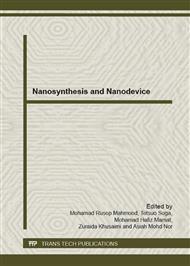[1]
J. Curtis, M. Greenberg, J. Kester, S. Phillips, and G. Krieger, Nanotechnology and Nanotoxicology: A Primer for Clinicians, Toxicological Reviews 25 (2006) 245-260.
DOI: 10.2165/00139709-200625040-00005
Google Scholar
[2]
M. B Lai, S. Jndhyam, V. V. Dukhande, A. Bushan, C. K. Daniels, S. W. Leung and J. C. K. Lai, Cytotoxicity of Metallic Oxide Nanoparticles in Human Neuronal and Non-Neuronal Cells, Technical Proceeding- Nanotechnology Life Sciences, Medicine, Diagnostics, Bio Materials and Composites 2 (2009).
Google Scholar
[3]
R. N. Seetharam and K. R Sridhar, Nanotoxicity: Threat Posed by Nanoparticles, Current Science 93 (2007) 769-770.
Google Scholar
[4]
Z. Chen, H. Meng, G. Xing, C. Chen, Y. Zao, G. Jia, T. Wang, H. Yuan, C. Ye, F. Zhao, Z. Chai, C. Zhu, X Fang, B. Ma and L. Wan, Acute Toxicological Effects of Copper Nanoparticles in Vivo, Toxicological Letters 163 (2006) 109-120.
DOI: 10.1016/j.toxlet.2005.10.003
Google Scholar
[5]
J. X. Wang, G. Q Zhou, C. Y. Chen, H. W. Yu, T. C. Wang, Y. M. Ma, G. Jia, Y. X. Gao, B. Li, J. Sun, Y. F. Li, F. Jiao, Y. L. Zhao and Z. F. Chai, Acute Toxicity and Biodistribution of Different Sized Ttitanium Dioxide Particles in Mice After Oral Administration. Toxicol. Lett 168 (2007).
DOI: 10.1016/j.toxlet.2006.12.001
Google Scholar
[6]
H. Xie, L. Hu G. and Li, SH-SY5Y Human Neuroblastoma Cell Line: in Vitro Cell Model of Dopaminergic Neurons in Parkinson's Disease. Chin Med 123 (2010) 1086-1092.
Google Scholar
[7]
D. V. D. Merwe, S. Tawde, J. A. Picrell and L. E. Erickson, Nanocrystalline Titanium Dioxide and Magnesium Oxide in Vitro Dermal Absorption in Human Skin 28 (2009) 78-82.
DOI: 10.1080/15569520902914926
Google Scholar
[8]
M. Encinas, M. Iglesias, Y. Liu, H. Wang, A. Muhaisen, V. Ceῆa, C. Gallego and J. X. Comella, Sequential treatment of SH-SY5Y cels with retinoic acid and brain-derived neutrophic factor gives rise to fully differentiated, neutrophic factor-dependant, human neuron-like cells. Journal of Neurochemistry 75 (2000).
DOI: 10.1046/j.1471-4159.2000.0750991.x
Google Scholar
[9]
Z. Datki, A. Juhász, M. Gálfi, K. Soós, R. Papp and D. Zádori, Method for measuring neurotoxicity of aggregating polypeptides with the MTT assay on differentiated neuroblastoma cells. Brain Res Bull (2003) 223-229.
DOI: 10.1016/j.brainresbull.2003.09.011
Google Scholar
[10]
P. S. Flectcher, G. S. Wallace, P. M. Mesquite and R. J. Shattock, Candidate polyanion microicides inhibit HiV-1 infection and dissemination pathways in human cervical explants. Retrovirology 62 (2006) 46.
DOI: 10.1186/1742-4690-3-46
Google Scholar
[11]
Nel, Andre, T. Xia, L. Madler, and N. Li, Toxic Potential of Materials at the Nanolevel, Science 311 (2006) 622-627.
DOI: 10.1126/science.1114397
Google Scholar
[12]
R. P. Bagwe, L. R. Hilliard and W. Tan, Surface modification of silica nanoparticles to reduce aggregation and nonspecific binding. Langmuir 22 (2006) 4357-4362.
DOI: 10.1021/la052797j
Google Scholar


